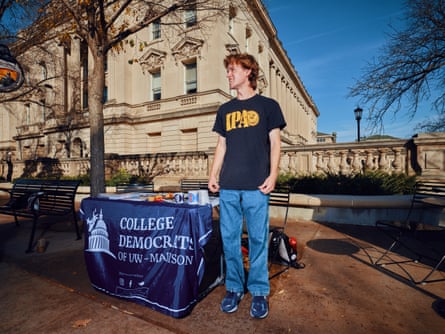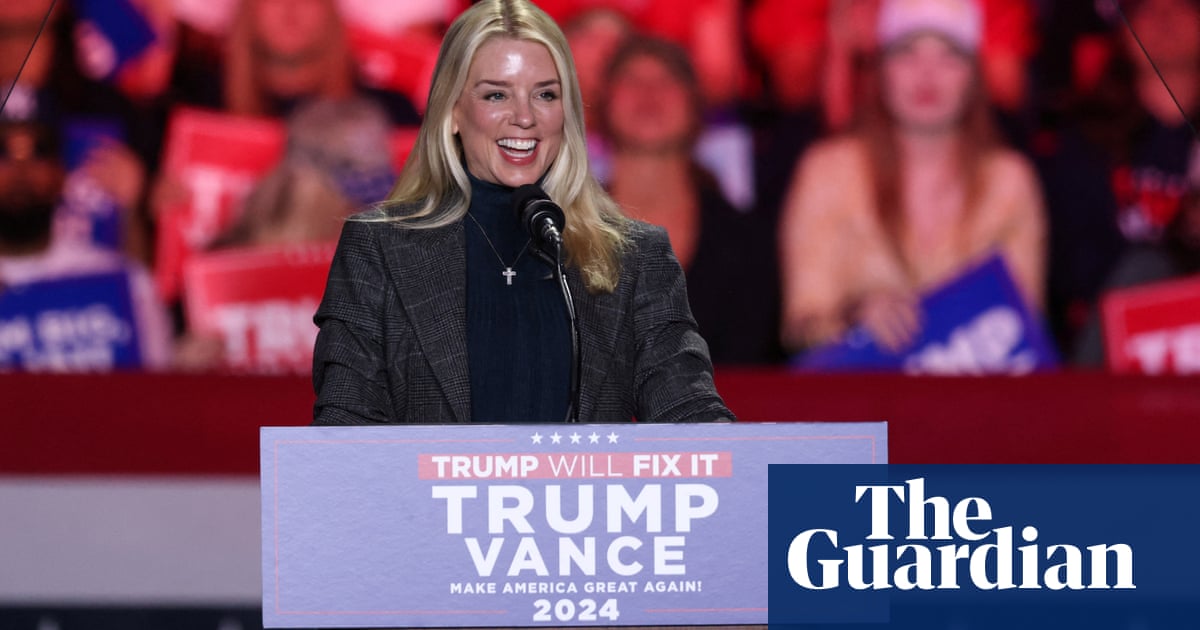On a warm October morning in Madison, Wisconsin, Ty Schanhofer found a unicorn: an undecided voter.
Schanhofer, an organizer with the University of Wisconsin student Democratic party, had unfolded a plastic table on campus and was trying to encourage people to register in the key swing state.

When Arin Mahapatra, a 21-year-old student from Illinois, stopped by, Schanhofer – who takes an English class with Mahapatra – jumped into action, peppering him with questions and offering reasons to support Harris.
“I’m not necessarily [leaning] in a certain direction, I’m just trying to find out who exactly falls in the same line with what I value most,” said Mahapatra, who cited economic issues like the price of gas and cost of student housing as his top concerns.
Truly undecided voters are rare in Wisconsin, where presidential elections hinge on the narrowest of margins.
“I feel like it’s probably 2% of the voters who are undecided,” said Schanhofer. “It’s not many at all.”
Winning the support of young voters like Mahapatra will be crucial for Harris or Trump to pull off a victory in Wisconsin, where students and voters under 30 have turned out in record numbers in recent elections. In 2023, students on college campuses across the state rallied to elect a liberal judge to the Wisconsin supreme court, helping shift the ideological leaning of the bench in hopes that the court would help establish abortion rights in the state.

People like Schanhofer hope that by generating this kind of turnout among young voters, they’ll be able to turn the Wisconsin electorate in Harris’s favor.
The Badger state is considered to be part of the “blue wall” – the states Democrats consistently won in the 1990s and early 2000s.
But vanishingly narrow margins in the state decided the 2016 and 2020 elections, and today Wisconsin is a virtual toss-up in the polls, as are many of the other six swing states.
Trade unions historically helped drive voter turnout for Democrats, but a series of anti-labor laws passed under the Republican-controlled state government in 2011 dealt them a blow. Rural areas have increasingly turned to Republican candidates, leaving cities like Milwaukee – Wisconsin’s most racially diverse – and the liberal stronghold of Madison as Democratic bastions.

This election will probably come down to turnout, with the Trump and Harris campaigns attempting to shear away voters from each other’s respective bases. For Trump, that means drawing in young men, who have increasingly drifted to the right.
On 26 October, some of those voters could be found queueing up around the corner for an event at the Kollege Klub, a bar just blocks from where the campus Democrats have been tabling for Harris.
For hours, the bar was only admitting ticketed attendees, who had spent $150 to see the rightwing Nelk Boys, YouTube pranksters whose podcast has featured the self-proclaimed misogynist Andrew Tate and Trump himself. The Nelk Boys promised to feature Charlie Kirk, the founder of the Maga organizing hub Turning Point USA (TPUSA), as a special guest.
Eric Davis, a 29-year-old who lives and works in Madison, waited in line with his friends for more than two hours in front of the bar. Davis voted for Joe Biden in 2020, but said he’s reversing course this year.
“I switched over to Trump because I just think, honestly, our economy right now is not going the way that it should,” said Davis. “I don’t believe in everything he says, but a majority of the stuff he goes with – I’m with it.”

Davis, who is Black, doesn’t always like how Trump talks about immigrants, thinks the ex-president can be crass and understands why he rubs people the wrong way. But the way Davis sees it, that’s just Trump being Trump.
“I don’t think he’s racist at all,” said Davis.
“My whole family, they’re all liberals,” added Davis, who has not yet told his family how he planned to vote.
Despite the night’s political theme, the actual gathering featured little by way of political mobilization. The Nelk Boys stood on a raised platform in the venue, throwing Trump merchandise into the crowd, but Kirk was nowhere to be seen. A stack of cards with voter registration information sat forgotten on a table crowded with beer bottles.
after newsletter promotion

But for Brandon Maly, the chair of the Republican party of Dane county, the night was a success.
“I’ve never seen a bar in Madison packed with Maga hats, it was just incredible. I love to see it – it’s part of that psychology in Dane county, that people need to be given a permission structure,” said Maly. “You may not think it translates to votes, but it does in the sense that they’re given permission to support Trump.”
Maly has no illusions about turning Dane county red.
But given its status as the second most populous county in the state, he sees the area as a rich source of Republican voters – no matter how marginal their political views may be locally.

His goal, of chipping away at Democratic party margins in liberal hubs, is mirrored in Democrats’ push to fight back Republican party majorities in rural and suburban parts of the state that have historically leaned red.
One of those Democratic party organizers is Deb Dassow, the chair of the Ozaukee county Democratic party, who says she feels she has the shifting political winds at her back. In Ozaukee county, which stretches north of Milwaukee along Lake Michigan, Democrats have begun to make gains in the last several election cycles. In 2012, Barack Obama claimed 34% of the vote. In 2016, Hillary Clinton took 37%, and in 2020 Biden pulled 43% of the vote there.
Since 2019, when the Ozaukee county Democrats opened a permanent office in the county, the local party chapter has poured resources into organizing local Democrats.
“Since April, we’ve knocked 25,000 doors – we knocked 5,000 just last weekend,” said Dassow on 25 October. The local Democrats have facilitated food drives, held parties and hosted beading parties, crafting red, white and blue bracelets emblazoned with the letters K-A-M-A-L-A.
Since jumping into the race in July, the vice-president and her allies have raised more than $1bn to fuel her campaign; much of those funds have poured into a broad campaign to knock on thousands of doors across the country.
And not least, they are trying to turn out young people: according to a source familiar with the Harris-Walz campaign in Wisconsin, the Democratic coordinating campaign hired seven full-time campus organizers across the state and a youth-organizing coordinator before the election.

The Republican party, meanwhile, has farmed off most of its ground game to outside groups – including TPUSA and the tech billionaire Elon Musk’s America Pac. Those groups allied with the Trump campaign have sought to turn out “low-propensity” voters for Trump, in particular, targeting rural would-be Trump voters who might otherwise neglect to cast a ballot at all.
The Trump campaign touts the strategy as innovative, but neither TPUSA nor America PAC boast the kinds of detailed voter lists that parties traditionally maintain to target supporters.
“There’s suspicion as to whether or not this is an actual ground game,” said Brandon Scholz, a former Republican party operative who left the GOP on 7 January 2021 – the day after Trump supporters contesting the 2020 election results stormed the US Capitol. Even as an independent, Scholz maintains close relationships in the party and has followed the 2024 campaigns with keen interest.
“Are these folks really here?” said Scholz. “Are they really beating the hell out of the doors? Are they really identifying and getting ready to turn out voters, or getting them out to vote early, or getting them absentee ballots?”
The answers to these questions – is Trump’s ground strategy as haphazard as it seems in Wisconsin, and is the Harris turnout machine as effective as Democrats claim? – could very well determine the outcome of the election.

 German (DE)
German (DE)  English (US)
English (US)  Spanish (ES)
Spanish (ES)  French (FR)
French (FR)  Hindi (IN)
Hindi (IN)  Italian (IT)
Italian (IT)  Russian (RU)
Russian (RU)  2 weeks ago
2 weeks ago
























Comments